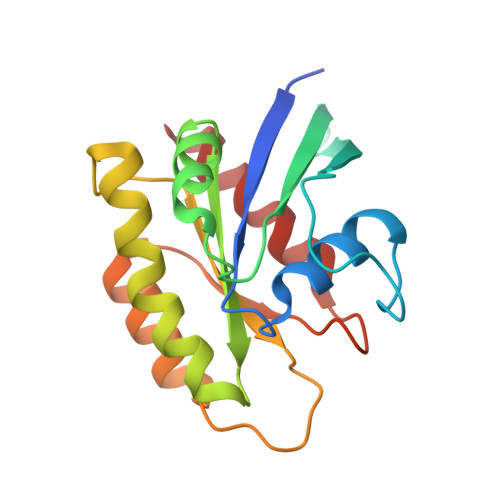Solution structure of the state 1 conformer of GTP-bound H-Ras protein and distinct dynamic properties between the state 1 and state 2 conformers.
Araki, M., Shima, F., Yoshikawa, Y., Muraoka, S., Ijiri, Y., Nagahara, Y., Shirono, T., Kataoka, T., Tamura, A.(2011) J Biol Chem 286: 39644-39653
- PubMed: 21930707
- DOI: https://doi.org/10.1074/jbc.M111.227074
- Primary Citation of Related Structures:
2LCF - PubMed Abstract:
Ras small GTPases undergo dynamic equilibrium of two interconverting conformations, state 1 and state 2, in the GTP-bound forms, where state 2 is recognized by effectors, whereas physiological functions of state 1 have been unknown. Limited information, such as static crystal structures and (31)P NMR spectra, was available for the study of the conformational dynamics. Here we determine the solution structure and dynamics of state 1 by multidimensional heteronuclear NMR analysis of an H-RasT35S mutant in complex with guanosine 5'-(β, γ-imido)triphosphate (GppNHp). The state 1 structure shows that the switch I loop fluctuates extensively compared with that in state 2 or H-Ras-GDP. Also, backbone (1)H,(15)N signals for state 2 are identified, and their dynamics are studied by utilizing a complex with c-Raf-1. Furthermore, the signals for almost all the residues of H-Ras·GppNHp are identified by measurement at low temperature, and the signals for multiple residues are found split into two peaks corresponding to the signals for state 1 and state 2. Intriguingly, these residues are located not only in the switch regions and their neighbors but also in the rigidly structured regions, suggesting that global structural rearrangements occur during the state interconversion. The backbone dynamics of each state show that the switch loops in state 1 are dynamically mobile on the picosecond to nanosecond time scale, and these mobilities are significantly reduced in state 2. These results suggest that multiconformations existing in state 1 are mostly deselected upon the transition toward state 2 induced by the effector binding.
Organizational Affiliation:
Department of Chemistry, Kobe University Graduate School of Science, 1-1 Rokkodai, Nada-ku, Kobe 657-8501, Japan.
















